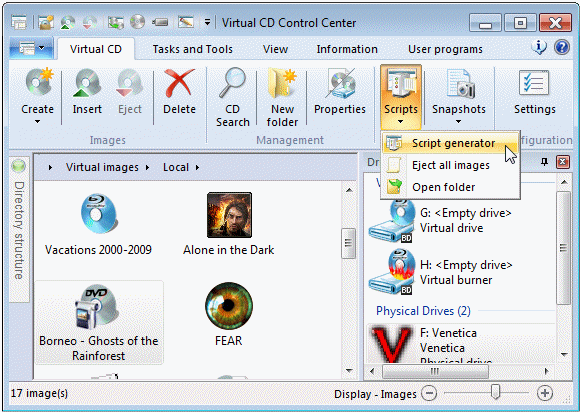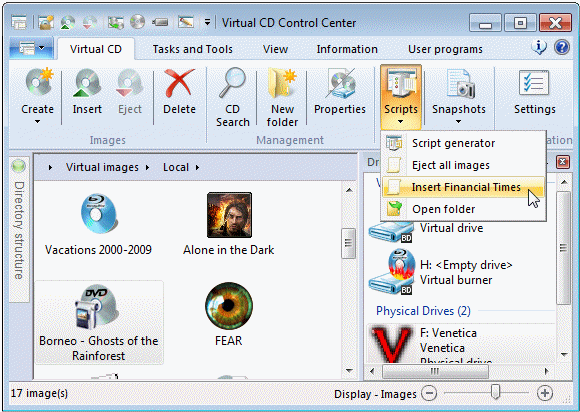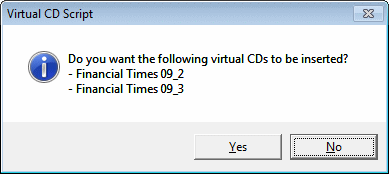The Script Generator makes scripts that execute the following commands:
| ► | Insert virtual CD(s) and/or ISO image(s) |
| ► | Eject virtual CD(s) and/or ISO image(s) |
Scripts that insert virtual CDs are especially useful for applications that use more than one virtual CD. The only limiting factor is the number of virtual drives available for the required virtual CDs.
The Script Generator creates a Visual Basic script (*.vbs). The virtual CDs designated in a VBS file are inserted or ejected over the Virtual CD application programming interface (API). On the Virtual CD tab in the Ribbon, click on Scripts to access scripts and related commands. The first item in the menu that opens is Script Generator for creating scripts. Any existing scripts are listed below that. Simply select a script to run it. The last item in the menu, Open folder, gives you direct access to the script by opening the Scripts folder in the Windows Explorer.

|
If you plan to use a script frequently, we recommend selecting the Create a shortcut on the desktop option in the Script Generator. Then you can execute the script by double-clicking on the shortcut.
|
Scripts can be very handy, and no programming skills are required to make a Virtual CD script. The following example demonstrates how to make and use a script that inserts virtual CDs.
|
Run the Script Generator |
Open the CD Control Center and select the virtual CDs you want to have inserted by the script. Then open the Virtual CD tab, click on Scripts, and select Script Generator from the menu.

|
When you open the Script Generator from the CD Control Center, the select CDs are automatically listed in the Script Generator program window for inclusion in the script. If you selected a folder in the CD Control Center, all CDs in that folder are added to the list. |
|
An easy way to write a script that includes certain virtual CDs is to insert those virtual CDs yourself, run the Script Generator (for example, by selecting it in the Quick Start menu) and select Snapshot. The Script Generator opens with a new script window that includes all of the virtual CDs currently in drives. Now you can adapt the script as desired. |
|
Generate the script |
In this example, we will simply have our virtual CD inserted. All other fields retain their default values.
|
Before generating a script, you can test whether it works and make sure it performs as expected by clicking on Test. This generates a temporary script in accordance with the settings active in the Script Generator, and executes it. |
Once the script is ready, click on Generate to write it. This opens the standard "Save as..." dialog for entering a file name. We recommend choosing a descriptive name; one that conveys the purpose of the script even long after it was written.
|
The default path for saving the script is the Virtual CD script folder. If you select a different path, your script will not be displayed in your Virtual CD program windows, as the Virtual CD programs show only the scripts that are stored in the folder specified for that purpose in the Virtual CD Settings. |
|
Execute the script |
The new script is added to the menu the opens when you click on Scripts in the CD Control Center. Simply select it from the menu to execute it.

If you left the Prompt user for confirmation before executing option active (default setting) when making the script, a window opens at this point telling you what the script will do and prompting you to either confirm or cancel the operation.

|
If you want to make use of Virtual CD scripts, we recommend experimenting with the various settings in the Script Generator to get an idea of the possibilities offered. |
|
If you are familiar with scripts and want write your own, with other functions than those available in the Script Generator, open the Information tab in the Ribbon of the CD Control Center and select the Virtual CD v10 API documentation. This file contains detailed descriptions of all the functions available over the Virtual CD API. |
